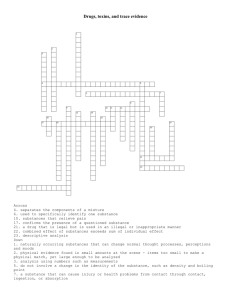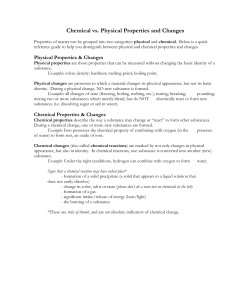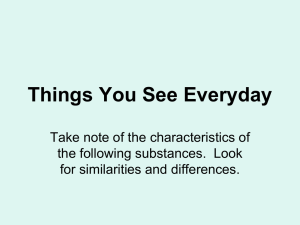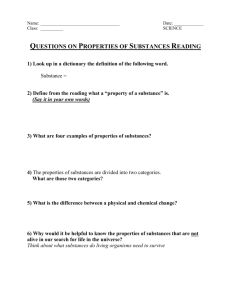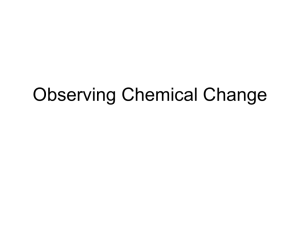Chemical Substance Classification Experiment Guide
advertisement
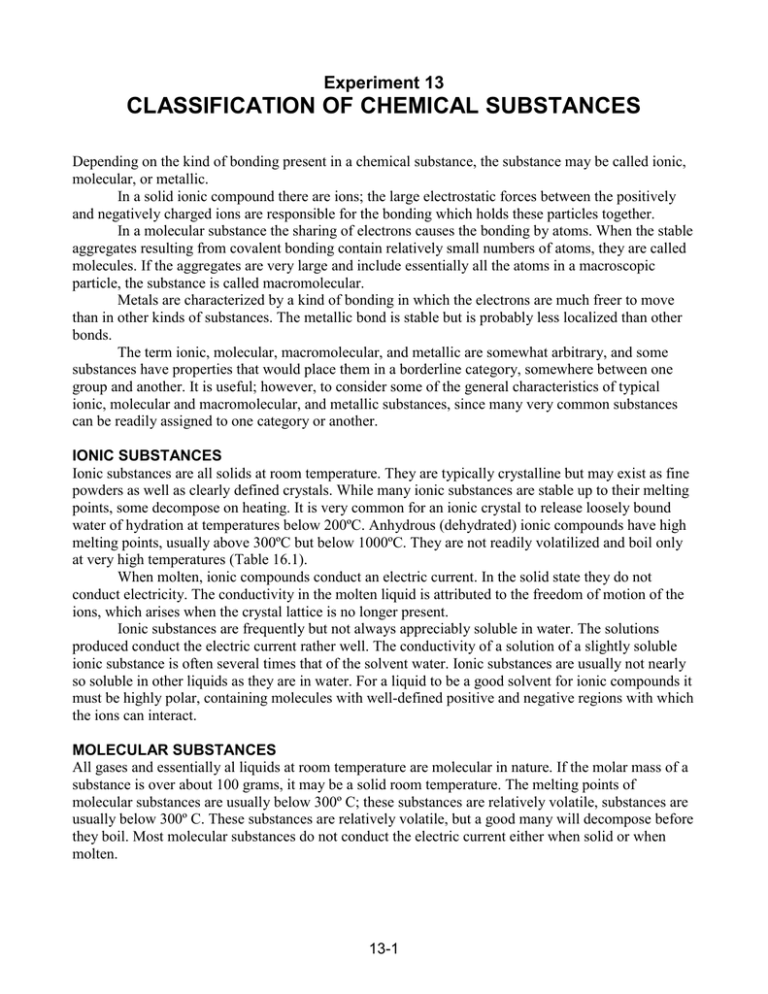
Experiment 13 CLASSIFICATION OF CHEMICAL SUBSTANCES Depending on the kind of bonding present in a chemical substance, the substance may be called ionic, molecular, or metallic. In a solid ionic compound there are ions; the large electrostatic forces between the positively and negatively charged ions are responsible for the bonding which holds these particles together. In a molecular substance the sharing of electrons causes the bonding by atoms. When the stable aggregates resulting from covalent bonding contain relatively small numbers of atoms, they are called molecules. If the aggregates are very large and include essentially all the atoms in a macroscopic particle, the substance is called macromolecular. Metals are characterized by a kind of bonding in which the electrons are much freer to move than in other kinds of substances. The metallic bond is stable but is probably less localized than other bonds. The term ionic, molecular, macromolecular, and metallic are somewhat arbitrary, and some substances have properties that would place them in a borderline category, somewhere between one group and another. It is useful; however, to consider some of the general characteristics of typical ionic, molecular and macromolecular, and metallic substances, since many very common substances can be readily assigned to one category or another. IONIC SUBSTANCES Ionic substances are all solids at room temperature. They are typically crystalline but may exist as fine powders as well as clearly defined crystals. While many ionic substances are stable up to their melting points, some decompose on heating. It is very common for an ionic crystal to release loosely bound water of hydration at temperatures below 200ºC. Anhydrous (dehydrated) ionic compounds have high melting points, usually above 300ºC but below 1000ºC. They are not readily volatilized and boil only at very high temperatures (Table 16.1). When molten, ionic compounds conduct an electric current. In the solid state they do not conduct electricity. The conductivity in the molten liquid is attributed to the freedom of motion of the ions, which arises when the crystal lattice is no longer present. Ionic substances are frequently but not always appreciably soluble in water. The solutions produced conduct the electric current rather well. The conductivity of a solution of a slightly soluble ionic substance is often several times that of the solvent water. Ionic substances are usually not nearly so soluble in other liquids as they are in water. For a liquid to be a good solvent for ionic compounds it must be highly polar, containing molecules with well-defined positive and negative regions with which the ions can interact. MOLECULAR SUBSTANCES All gases and essentially al liquids at room temperature are molecular in nature. If the molar mass of a substance is over about 100 grams, it may be a solid room temperature. The melting points of molecular substances are usually below 300º C; these substances are relatively volatile, substances are usually below 300º C. These substances are relatively volatile, but a good many will decompose before they boil. Most molecular substances do not conduct the electric current either when solid or when molten. 13-1 Table 1 Physical Properties of Some Representative Chemical Substance Solubility Substance M.P., ºC B.P., ºC Water Hexane NaCl 801 1413 Sol Insol MgO CoCl2 CoCl2·6H2O 2800 Sublimes 86 _____ 1049 Dec Sl sol Sol Sol Insol Insol Insol C10H8 C6H5COOH FeCl3 70 122 282 255 249 315 Insol Sl sol Sol Sol Sl sol Sl sol SnI4 SiO2 Fe 144 1600 1535 341 2590 3000 Dec Insol Insol Sol Insol Insol Electrical Conductance High in melt and in soln Low in sat’d soln High in soln High in soln Zero in melt Low in sat’d soln High in soln and in melt ~ Zero in melt Zero in solid High in solid Classification Ionic Ionic Ionic Ionic hydrate, -H2O at 110º C Molecular Molecular-ionic Molecular-ionic Molecular Macromolecular Metallic Key: Sol = at least 0.1 mole/L; Sl sol = appreciable solubility but < 0.1 mole/L; Insol = essentially insoluble; Dec = decomposes. substances are usually below 300º C; these substances are relatively volatile, but a good many will decompose before they boil. Most molecular substances do not conduct the electric current either when solid or when molten. Organic compounds, which contain primarily carbon and hydrogen, often in combination with other nonmetals, are essentially molecular in nature. Since there are a great many organic substances, it is true that most substances are molecular. If an organic compound decomposes on heating, the residue is frequently a black carbonaceous material. Reasonably large numbers of inorganic substances are also molecular; those that are solids at room temperature include some of the binary compounds of elements in Groups 4, 5, 6 and 7. Molecular substances are usually soluble in at least a few organic solvents, with the solubility being enhanced if the substance and the solvent are similar in molecular structure. Some molecular compounds are markedly polar, which tends to increase their solubility in water and other polar solvents. Such substances may ionize appreciably in water, or even in the melt, so that they become conductors of electricity. Usually the conductivity is considerably lower than that of an ionic material. Most polar molecular compounds in this category are organic, but a few, including some of the salts of the transition metals, are inorganic. MACROMOLECULAR SUBSTANCES Macromolecular substances are classified as either inorganic or organic. Inorganic macromolecular substances are all solids at room temperature. They have very high melting points, usually above 1000ºC, and low volatility. They are typically very resistant to thermal decomposition. They do not conduct electric current and are often good insulators. They are not soluble in water or any organic solvents. They are frequently chemically inert and may be used as abrasives or refractories. Organic macromolecular substances (polymers, plastics, elastomers, coatings, carbohydrates, proteins, and adhesives) properties have the wider variation than the inorganic subgroup. Organic macromolecular substances are normally solids at room temperature. Their hardness ranges from 13-2 extremely soft to extremely hard. They have melting points more in the range of molecular substances. They do not conduct electricity and are used as insulators when the end-use temperature will be below the melting point of the polymer. Their solubility mirrors those of molecular substances. Organic macromolecules are soluble, with the solubility being enhanced if the substance and the solvent are similar in molecular structure. They are chemically reactive with properties more similar to molecular substances than those of inorganic macromolecules are. METALLIC SUBSTANCES The properties of metals appear to derive mainly from the freedom of movement of their bonding electrons. Metals are good electrical conductors in the solid form, and have characteristic luster and malleability. Most metals are solid at room temperature and have melting points that range from below 0ºC to over 2000ºC. They are not soluble in water or organic solvents. Some metals are prepared as gray or black powders, which may not appear to be electrical conductors. However, if one measures the conductance while the powder is under pressure, its metallic character is revealed. WEAR YOUR SAFETY GLASSES WHILE PERFORMING THIS EXPERIMENT EXPERIMENTAL PROCEDURE In this experiment you will investigate the properties of several substances with the purpose of determining whether they are molecular, ionic, macromolecular, or metallic. In some cases the classification will be very straightforward. In others the assignment to a class will not be so easy and you may find that the substance has a behavior associated with more than one class. As the discussion indicates, there are several properties we can use to find out to which class a substance belongs. In this experiment we will use the melting point, solubility in water and organic solvents, and electrical conductivity of the aqueous solution, the solid, and the melt in making the classification. The substances to be studied in the first part of the experiment are on the laboratory tables along with two organic solvents, one polar and one nonpolar. You need only carry out enough tests on each substance to establish the class, to which it belongs, so you will not need to perform every test on every substance. You may, however, carry out any extra tests you wish, if only to satisfy your curiosity. Follow the directions for each test as given below. Melting Point Approximate melting points of substances can be determined rather easily. Substances with low melting points, less than 100ºC, will melt readily when warmed gently in a small test tube. A sample the size of a pea will suffice. If the sample melts between 100º and 300ºC, it will take more than gentle warming, but will melt before the test tube imparts a yellow-orange color to the Bunsen flame. Above 300ºC, there will be increasing color; up to about 500ºC one can still use a test tube and a strong burner flame; but at about 550ºC the pyrex tube will begin to soften. In this experiment we will not attempt to measure any melting points above 500ºC. While heating a sample, keep the tube loosely stoppered with a cork. Do not breathe any vapors that are given off, and do not continue to heat a sample after it has melted. As you heat the sample, look for evidence of decomposition, sublimation, or evolution of water. 13-3 Solubility and Conductance of Solutions In testing for solubility, again use a sample about the size of a pea, this time in a regular test tube. Use about 2mL of solvent, enough to fill the tube to a depth of about 1/2 inch. Stir well, using a clean stirring rod. Some samples will dissolve completely almost immediately; some are only slightly soluble and may produce a cloudy suspension; others are completely insoluble. Make solubility tests with deionized water and the two organic solvents and record your results. Use fresh deionized water in your wash bottle for the solubility tests. Conductance measurements need only be made on water solutions. We will use portable ohmmeters for this purpose. Your instructor may make the measurements for you, but may have you make them. An ohm-meter measures the electrical resistance of a sample in ohms, Ω. A solution with a high resistance has a low electrical conductance, and vice versa. Some of your solutions will have a low resistance, of the order of 1000Ω or less; these are good conductors. Distilled water has a high resistance; with your meter it will probably have a resistance of 50,000Ω or greater. Small amounts of contaminants can lower the resistance of solution very markedly, particularly if the main solute shows high resistance. Measure the resistance of any of the aqueous solutions containing soluble or slightly soluble substances. Between tests, rinse the electrodes in a beaker filled with distilled water. For our purposes, a solution with a resistance less than about 2000Ω is a good conductor, G. Between 2000 and 20,000Ω it is a weak conductor, W. Above 20,000Ω we will consider it to be essentially nonconducting, N. Record the resistances you observe in ohms. Then note, with a G, W, or N, whether the solution is a good, weak, or poor conductor. Electrical Conductance of Solids Some substances conduct electricity in the solid state. If the sample contains large crystals, the conductance test is very easy. Select a crystal, put it on the lab bench, and touch it with the two wires on the ohm-meter probe. Metals have a very low resistance. In powder form most substances, metals included, appear to have essentially infinite resistance. However, under pressure, metal powders, unlike those of other substances, show good conductance. To test a powder for conductance, put a penny on the lab bench. On it place a small rubber washer from the box on the bench. Fill the hole in the washer with the powder, and put another penny on top of the washer. Put the whole sandwich between the jaws of a pair of insulated pliers. Touch the electrodes from the ohm-meter probe to the pennies, one electrode to each penny, and squeeze the pliers. If the powder is a metal, the resistance will gradually fall from infinity to a small value. Make sure the pennies touching each other do not cause any drop in resistance. Record your results. Having made the tests we have described, you should be able to assign each substance to its class, or, possible, to one or both of two classes. Make this classification for each substance, and give your reasons for doing so. When you have classified each substance, report to your laboratory supervisor, who will assign you two unknowns for characterization. All residues from your tests should be discarded in the waste crock unless directed otherwise by your instructor. 13-4 OBSERVATIONS AND CONCLUSIONS: CLASSIFICATION OF CHEMICAL SUBSTANCES Name _____________________ Instructor ___________ Date _______ Table 2 Substance No. Approx. Melting Pt., ºC (<100, 100-300, 300-500, >500) Solubility Polar Nonpolar H2O Organic Organic Electrical resistance, Ω Solution in H2O Solid I II III IV V Unknown No. ___________ ___________ Key: Sol = soluble; Sl sol = slightly soluble; Insol = insoluble; G = good electrical conductor, R < 2000Ω; < W = weak electrical conductor, 2000Ω < R < 20,000Ω; N = nonconductor, R > 20,000Ω 13-5 Advance Study Assignment: Classification of Substances Name _____________________ Instructor ___________ Date _______ 1. List the properties of a substance that would definitely establish that the material is molecular. 2. If we classify substances as ionic, molecular, macromolecular, or metallic, in which, if any categories are all the members a. soluble in water? b. electrical conductors in solution? c. insoluble in all common solvents? d. solids at room temperature? 3. A given substance is a white solid at 25ºC. It melts at 250ºC without decomposing, and soluble in both polar and non-polar solvents but not water. What would be the classification of the substance, based on this information? 4. A white solid melts at 1000ºC. The melt does not conduct electricity. Classify the substance as best you can from these properties. 13-6
